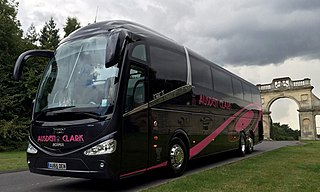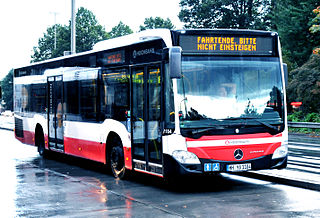
A bus is a road vehicle that carries significantly more passengers than an average car or van. It is most commonly used in public transport, but is also in use for charter purposes, or through private ownership. Although the average bus carries between 30 and 100 passengers, some buses have a capacity of up to 300 passengers. The most common type is the single-deck rigid bus, with double-decker and articulated buses carrying larger loads, and midibuses and minibuses carrying smaller loads. Coaches are used for longer-distance services. Many types of buses, such as city transit buses and inter-city coaches, charge a fare. Other types, such as elementary or secondary school buses or shuttle buses within a post-secondary education campus, are free. In many jurisdictions, bus drivers require a special large vehicle licence above and beyond a regular driving licence.

A coach is a type of bus built for longer-distance service, in contrast to transit buses that are typically used within a single metropolitan region. Often used for touring, intercity, and international bus service, coaches are also used for private charter for various purposes. Coaches are also related and fall under a specific category/type of RVs.

An articulated bus, also referred to as a banana bus, bendy bus, tandem bus, vestibule bus, wiggle wagon, stretch bus, or an accordion bus, is an articulated vehicle used in public transportation. It is usually a single-decker, and comprises two or more rigid sections linked by a pivoting joint (articulation) enclosed by protective bellows inside and outside and a cover plate on the floor. This allows a longer legal length than rigid-bodied buses, and hence a higher passenger capacity (94–120), while still allowing the bus to maneuver adequately.

The Mercedes-Benz O305 was a single deck, double deck and articulated bus manufactured by Mercedes-Benz in Mannheim, West Germany from 1968 until 1988. It was built as either a complete bus or a bus chassis and was the Mercedes-Benz adaptation of the unified German VöV-Standard-Bus design, that was produced by many different bus manufacturers including Büssing, Magirus-Deutz, MAN, Ikarus, Gräf/Steyr, Heuliez, Renault, and Pegaso. The O305 was designed for use as a single-decker bus, however it was later redesigned to accommodate double-decker bodies.

The Mercedes-Benz Citaro is a single-decker, rigid or articulated bus manufactured by Mercedes-Benz/EvoBus. Introduced in 1997, the Citaro is available in a range of configurations, and is in widespread use throughout Europe and parts of Asia, with more than 55,000 produced by December 2019.

Van Hool NV is a Belgian family-owned coachbuilder and manufacturer of buses, coaches, trolleybuses, and trailers.

Mercedes-Benz has been producing buses since 1895 in Mannheim in Germany. Since 1995 Mercedes-Benz buses and coaches is a brand of EvoBus GmbH, a wholly owned subsidiary of Daimler Truck.

Switch Mobility is an English bus manufacturer based in Sherburn-in-Elmet, North Yorkshire. It is a subsidiary of Indian company Ashok Leyland. The company would be responsible for the EV operations of the group with Ashok Leyland focusing on its core business of diesel-powered vehicles as well as work on alternative fuels like compressed natural gas (CNG), liquefied natural gas (LNG) and hydrogen.

The Scania OmniCity is an integrally constructed transverse-engined low floor city bus that was available from Scania on the European market between 1997 and 2012.

The Mercedes-Benz O405 was a single-decker bus manufactured by Mercedes-Benz from the mid-1980s to the early 2000s as either an integral bus or a bus chassis and was the last VöV SL-II standard bus in production. It was the replacement for the Mercedes-Benz O305 and was widely used in Europe, the United Kingdom, Australia and Singapore with 12,000 produced.

A semi-trailer is a trailer without a front axle. In the United States, the term is also used to refer to the combination of a truck and a semi-trailer; a tractor-trailer.

Charles H Roe was a Yorkshire coachbuilding company. It was for most of its life based at Crossgates Carriage Works, in Leeds.

The Scania 4-series low floor city bus and coach range was introduced by Scania in 1997 as a successor to the 3-series bus range.

The MAN Lion's City is a range of low-floor and low-entry public buses built by German truck and bus manufacturer MAN Truck & Bus since 1996 primarily for the European market, but is also available in chassis-only variants worldwide. The name Lion's City has been used since 2006, when MAN's public bus models which had been marketed separately were gathered into one range, when also most models received a facelift. The first models to be introduced were the 12-metre low-floor intercity bus NÜ xx3 (A20) in 1996, the 12-metre city bus NL xx3 (A21) in 1997 and the articulated NG xx3 (A23) in 1998. As with former MAN bus models the power-rating made up part of the model name, giving the NÜ-series buses with power-ratings of 260 and 310 hp model names NÜ 263 and NÜ 313 respectively. The main production sites are in Starachowice and Sady in Poland, but the models have also been built in Germany, Turkey and Malaysia. Initially most of the midibus variants were manufactured by Göppel Bus in Augsburg, later Nobitz.

Arriva North West is a major bus operator running services in North West England primarily in the Merseyside area and the county of Cheshire. It is a subsidiary of Arriva UK Bus.

A multi-axle bus is a bus or coach that has more than the conventional two axles, usually three, or more rarely, four. Extra axles are usually added for legal weight restriction reasons, or to accommodate different vehicle designs such as articulation, or rarely, to implement trailer buses.

A single-decker bus or single-decker is a bus that has a single deck for passengers. Normally the use of the term single-decker refers to a standard two-axled rigid bus, in direct contrast to the use of the term double-decker bus, which is essentially a bus with two passenger decks and a staircase. These types of single-deckers may feature one or more doors, and varying internal combustion engine positions. The majority of single-deckers have a length of up to 12 metres, although some exceptions of longer buses exist. They also typically weigh between 11 and 14 tons.

Bus manufacturing, a sector of the automotive industry, manufactures buses and coaches.

The MAN NG272 was a low floor articulated single-decker bus built by MAN Nutzfahrzeuge from 1990 until 1992. It was an articulated development from the MAN NL202. Especially sold in Europe, in particular in Germany, it was replaced by the MAN NG272(2) (A11) in 1992.
The VöV-Standard-Bus is a standard for transit buses in Germany based on requirements by the VöV Association of German Transport Companies. The first concept was named Standard-Linienbus which resulted in multiple variants of VöV-Buses. The first generation was conceived in 1968 being in production to the mid 1980s when it was replaced by the second generation Standard-Linienbus II being in production up to 2000.




















